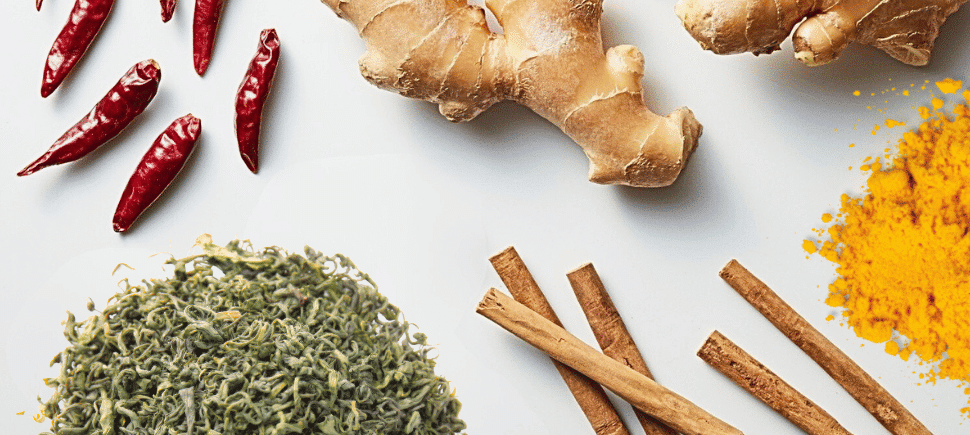Boost Your Metabolism Naturally: The Role of Herbs, Spices, and Movement
- by Christiane Matey
- Blog, Healthy Living, Weight Management

If you’ve ever envied those people who seem to eat whatever they want and still have energy to spare, chances are they’ve got one thing going for them: a metabolism that’s firing on all cylinders.
The good news? Your metabolism isn’t fixed. While genetics plays a role, you have more control than you might think. By making small, strategic changes to your daily habits—especially when it comes to food, movement, and stress—you can naturally nudge your metabolic rate in the right direction.
Ten Tips to Boost Your Metabolism
1. Prioritize Protein
Protein doesn’t just help you build muscle—it actually boosts the number of calories your body burns digesting it. This is thanks to something called the thermic effect of food (TEF), or the energy your body uses to chew, break down, absorb, and store nutrients. Out of the three macronutrients—protein, carbs, and fat—protein has the highest TEF.
That means when you eat a chicken breast or a scoop of Greek yogurt, your body works harder (aka burns more calories) to process it. And since muscle mass naturally decreases as we get older, those of us in the 40+ club should especially remember to include protein at meals and snacks.
Here are a few protein-rich ideas:
- Eggs with spinach for breakfast
- Grilled salmon over a quinoa salad
- A snack of cottage cheese and berries
Another protein perk:
Protein helps you feel full longer and reduces cravings, which means you’re less likely to reach for that mid-afternoon cookie.
2. Strength Train Like You Mean It

Muscle is a metabolically active tissue. In plain terms? It burns more calories than fat, even when you’re watching Netflix or sleeping. So, if you want your metabolism working for you 24/7, start lifting weights.
Strength training doesn’t have to mean heavy weights or a gym membership. Bodyweight exercises (think squats, lunges, and planks), resistance bands, or simple dumbbells can all do the trick.
Aim for this weekly goal:
Two to three strength training sessions per week, targeting all major muscle group. You’ll boost your metabolism, while building strength, improving balance, and decreasing your risk of injury.
3. Add in HIIT High-Intensity Interval Training (HIIT)
If you like short, efficient workouts with maximum return, try HIIT— alternating periods of intense activity and recovery. The best part: not only does HIIT torch calories during the workout itself, but it also keeps your metabolism elevated for hours afterward (aka the “afterburn” effect).
Try these simple HIIT workout ideas:
Start with a 30-second sprint, walk for 1 minute, and repeat the cycle for 15–20 minutes. Or do a bodyweight circuit alternating push-ups, jumping jacks, and mountain climbers. The key is intensity during the work periods and active recovery in between.
4. Drink More Water (Yes, Really)
Water is the unsung hero of metabolic health. Studies show that drinking water—especially cold water,—can temporarily increase your metabolic rate. That’s because your body uses energy to warm it to your internal temperature.
Beyond that minor bump in calorie burn, staying hydrated supports every cell and system in your body, including those that regulate digestion and energy use.
How much water do you need?
Aim for at least 8 cups of water a day (more if you’re sweating a lot or drinking caffeine). If plain water bores you, try adding citrus slices, fresh herbs, or cucumber to jazz it up.
5. Sip Caffeine… Strategically
Caffeine, in moderate doses, can give your metabolism a temporary boost by stimulating the central nervous system. That’s why you might feel a bit more energetic—and warm—after your morning cup of coffee or green tea.
Both coffee and green tea have compounds that may increase fat oxidation and support metabolism. But here’s the catch: too much caffeine can lead to jitters, sleep disruption, and even increased stress levels—which can have the opposite effect on metabolism.
How much caffeine should you drink?
Stick to one or two cups of coffee or caffeinated tea a day, preferably earlier in the day. And listen to how your body responds, too.
6. Spice Things Up
Capsaicin—the compound that gives chili peppers their heat—has been linked to increased caloric burn and fat oxidation. While eating spicy food won’t single-handedly melt fat, it can give your metabolism a little kick in the pants.

Other spices like ginger, turmeric, and cinnamon also show promising metabolic effects (more on that below). The best part? They make healthy meals taste amazing.
A few spicy tips:
You can add crushed red pepper to stir-fries, cinnamon to oatmeal, or turmeric to soups.
7. Sleep Like It’s Your Job
Your metabolism may pay the price when you skimp on sleep. Why? Sleep deprivation disrupts key hormones like ghrelin (which increases hunger) and leptin (which signals fullness). This leads to more cravings and a slower baseline calorie burn. It also raises cortisol levels—your primary stress hormone—which encourages fat storage, particularly around the midsection.
How much sleep should you get each night?
A good goal is seven to nine hours of quality sleep per night. And yes, that means powering down screens, ideally two hours before you go to bed. Your metabolism—and your mood—will thank you.
8. Manage Stress (So Your Hormones Can Chill)
Speaking of cortisol, chronic stress is a sneaky metabolism saboteur. Elevated stress hormones can promote fat storage, disrupt sleep, and even trigger emotional eating.
That’s why stress management isn’t just about feeling better—it’s a legit metabolic strategy.
What’s the best way to reduce stress?
There is no one-size-fits-all answer. Whether it’s a daily walk, meditation, deep breathing, or journaling, find a routine that helps you reset and unwind. It just needs to be something you enjoy doing.
Bonus points: Include movement, sunlight, or social connection—all of which have a positive impact on mental and metabolic health.
9. Eat More Whole, Unprocessed Foods
Not all calories are created equal. Whole foods—like fruits, vegetables, legumes, whole grains, and lean proteins—require more effort to digest and provide the nutrients your metabolism needs to run efficiently.
Processed foods, on the other hand, are typically digested quickly and offer little in terms of metabolic benefit. They also spike blood sugar and insulin levels—a recipe for energy crashes and increased fat storage.
10. Sit Less, Move More
Even if you work out regularly, sitting for most of the day can slow down your metabolism. Long periods of sitting can reduce calorie burn, slow circulation, and even alter how your body stores fat.
How can you add movement to your day?
Take walking meetings, stretch between tasks, or use a standing desk if you can. Every bit of motion helps your body stay in a more metabolically active state.
Herbs That Support Metabolism (Naturally, of Course)

Some herbs and spices have compounds that may gently nudge your metabolism. While they’re not magic bullets, incorporating them regularly can add up over time.
- Cayenne Pepper: Capsaicin increases energy expenditure and may suppress appetite.
- Green Tea Extract: EGCG + caffeine = metabolic synergy. Look for high-quality sources or sip steeped green tea daily.
- Ginger: A warming spice that may promote fat burning and help regulate appetite.
- Cinnamon: May support blood sugar balance and slightly boost thermogenesis.
- Turmeric: Curcumin has anti-inflammatory effects and may enhance fat metabolism.
- Ashwagandha: This adaptogen helps lower stress hormones, indirectly supporting healthy metabolism.
Supplements That May Help (But Aren’t a Shortcut)
Supplements can support your efforts, but they’re not a replacement for real food and movement. If you’re eating well, moving your body, and still struggling with energy or metabolism, these may help fill the gaps:
- B Vitamins (especially B6, B12, folate): Key players in converting food into usable energy.
- Iron: Essential for oxygen transport and cellular energy. Women and athletes may need more.
- Magnesium: Supports hundreds of biochemical reactions, including energy metabolism.
- L-Carnitine: Helps transport fatty acids into mitochondria, potentially aiding fat burning.
- CLA (Conjugated Linoleic Acid): A polyunsaturated fatty acid that may decrease body fat in some people.
- Berberine: May improve insulin sensitivity and support metabolic health.
- Elderberry: Rich in antioxidants that may reduce inflammation and improve fat oxidation.
A Word of Caution
Before you start mixing up herbal tonics or ordering every supplement from your favorite wellness influencer, pause.
Talk to your healthcare provider—especially if you’re on medication or managing a health condition. Stick with reputable brands and follow dosage recommendations.
Remember: supplements are sidekicks, not superheroes. They work best when paired with good sleep, regular physical activity, stress management techniques, and nutrient-rich meals.
Final Thoughts
You don’t need a gimmick or a 30-day cleanse to boost your metabolism. What works? Small, sustainable habits that support your body’s natural rhythms. Fuel it with whole foods, move it often, rest it well, and sprinkle in some spice—literally and figuratively.
And if you’re looking for personalized nutrition guidance rooted in science and tailored to your lifestyle, the MINT Nutrition team is here to help. Schedule a complimentary phone consultation today.
Share this Post

Christiane Matey
Integrative Nutritionist & Dietitian
